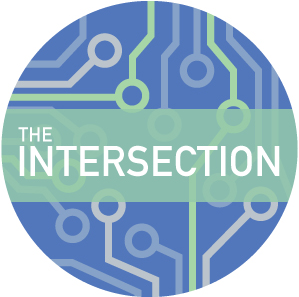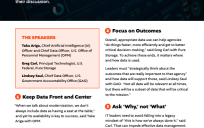
Aside from budgets, cultural barriers pose one of the greatest challenges to introducing new technologies and new ways of thinking into any agency.
There’s a certain way that people have always done things, and sometimes learning a new way can cause angst or pushback. So how do you foster an environment where people are open and excited about testing the waters and putting data analytics to use?
Maybe you’re well into your analytics journey, but you’ve hit a few snags and need some advice from your peers — or maybe you’re just beginning that journey. Wherever you are on that path, you can benefit from the lessons learned by others. GovLoop spoke with data experts from government and industry to glean practical tips for creating a culture for data analytics.
1. Understand data as a literacy. While technical skills are important, they are only truly valuable when combined with an understanding of data and problem-solving. “I always tell my students to understand data as a literacy,” said Kirk Borne, Principal Data Scientist at Booz Allen Hamilton and a former Professor of Astrophysics and Computational Science at George Mason University. “Literacy is knowing how to use data, when to use it, what types there are, and what types of questions it can answer.”
2. Recognize that data is an asset. Doing so gives data a prominent role. “Data is a binary representation of real information, and real information is what we are trying to extract,” Borne explained. You can use data to create better insights, decisions, services to citizens or other agencies.
3. Understand what your agency customers or partners want to accomplish. It’s not as simple as walking into someone’s office and asking them what they want. Sometimes they don’t know, and it may be hard for them to articulate it. Here’s where you need to sit down and have a two-way conversation. From that dialogue, you’ll be surprised at how much you learn about their data analytics needs. Not sure what to ask? Keep reading…
4. Go on a listening tour. What better way to find out what people need than actually talking to them? They may not be down the hall, but follow Caryl Brzymialkiewicz’s lead: When she became Chief Data Officer at the Department of Health and Human Services Office of the Inspector General, she scheduled coffee meetings and lunches with people onsite and held Skype calls with people in the field. If you’re not sure what to talk about, ask your colleagues or customers about their tension points, what they can’t access but want to access, and what would help them do their jobs better.
5. Make room at the table for a variety of participants. Indiana is a prime example of what can happen when agencies work together. The state’s Management and Performance Hub (MPH) is working with state agencies to explore what questions about Indiana’s opioid epidemic can be answered using government data and the state’s business intelligence tool. The ultimate goal: use the data to drive policy decisions. State agencies partnering with MPH will help shape how the business intelligence tool is used. “We really opened this up to the opportunity to continue to build on [the tool] with a number of different stakeholders and to bring everyone to the table,” said Joshua Martin Chief of Staff for MPH. But there’s more…
6. Keep everyone informed. Now that you’ve made room at the table for others to get involved, make sure you keep them updated. Martin and his colleagues have either met with or are scheduled to meet with every agency that is providing data to MPH. The goal is to show them what MPH is doing with their data and help them to better utilize their data to make decisions. “Once you can show your partners what you’re doing and what value you can extract from their data, participation usually picks up fairly rapidly,” Martin said.
7. Pull from your past experiences. Before starting his career as a state government employee, Martin spent six years in fire and EMS. His public safety background allows him to better communicate and relate to agencies that have a role in combating Indiana’s opioid epidemic. Consider past experiences you’ve had and how they can help you better communicate with colleagues and customers about their data and how it can be used.
8. Understand the jargon of the business. Another way of putting it: learn the lingo. Your data scientists and data management professionals have to familiarize themselves with the common terms and words their customers use. You have to understand the business and talk to them in their language, not in gigabytes and terabytes of data, said Linda Powell, Chief Data Officer at the Consumer Financial Protection Bureau. For example, “If I walk into an economist’s office and I don’t understand him when he is talking about doing a linear regression, he is going to kick me out.”
9. Consider the talent you have on board. Think about how to blend federal hiring with quick, commercial off-the-shelf software. Think about leveraging Presidential Management Fellows or a college intern to help you build your data analytics team. “Having one student on board can bring in new talent and thoughts,” Brzymialkiewicz said.
10. Consider rotation programs. Is there an entrepreneur in residence or an executive that you can bring on board to support your efforts? Does your agency provide rotational opportunities? At the federal level, the General Services Administration manages a program called Open Opportunities, which provides a platform for government employees to seek out new challenges or request the expertise of others in government.
How has your agency overcome cultural barriers and embraced data analytics? Feel free to share additional tips and advice in the comment section below. If you’re looking for more resources, check out GovLoop’s recent guide How You Can Use Data Analytics to Change Government.





Leave a Reply
You must be logged in to post a comment.